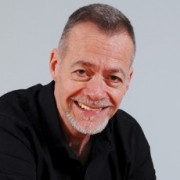
Gulf of Mexico at Fort Walton Beach, Florida, site of the Positive Living Conference
 This article was originally posted on TheBody.com on David's blog "Riding the Tiger: Life Lessons from an HIV-positive Therapist"
This article was originally posted on TheBody.com on David's blog "Riding the Tiger: Life Lessons from an HIV-positive Therapist"
Several attendees drove fifteen hours from St. Louis. Others came by caravan from Atlanta. In the hotel lobby there were happy reunions of friends who hadn't seen each other since last year. Overall nearly four hundred and fifty people made their way from 22 states to the white sandy beaches of the Florida panhandle in early March. It was spring break, but their purpose was much more a matter of life and death. They were gathering for Positive Living 15, the largest conference in the nation specifically for people living with HIV.
For fifteen years Butch McKay and his small staff at OASIS, the Okaloosa AIDS Support and Information Services, have somehow patched together a variety of funding to create a world-class conference where nationally-known figures share information and support with hundreds of persons living with the virus. A generous scholarship program underwrites the hotels and meals for most who otherwise would be unable to attend. Many have no other access to workshops where state of the art information as well as life-saving skills are shared in an atmosphere saturated with both laughter and heart.
The information provided is first rate. Martin Delaney, a prominent activist and founder of Project Inform, attended every Positive Living conference until his death. Other well-known figures continue to lead workshops and deliver keynote addresses. NMAC, the National Minority AIDS Council, provided support for an update on the 19th CROI (Conference on Retroviruses and Opportunistic Infections) which occurred just days before in Seattle. Additionally, the North Florida SHARP (State Healthcare Access Research Project) report was unveiled. This document, a project of the Harvard Law School and the Treatment Access Expansion Project, was one of several that have assembled critical data concerning states' capacities to meet the healthcare needs of people living with HIV. An annual Activate U Advocacy Academy provided invaluable training on basic advocacy skills and encouraged attendees to make their voice heard.
The workshops were informative, interactive and fun. Topics ranged from housing to ADAP, intimacy to trauma, and faith-based prevention to laughter therapy. There were groups for woman, transgendered, and men who have sex with men. In my own workshop about managing the effects of living with the virus year after year ("When the Crisis Lasts a Lifetime: HIV, Burnout, and Emotional Survival"), the attendees were hungry for information about both the physiological and emotional effects of stress and trauma as well as for solutions and skills to manage that stress.
The real magic of Positive Living doesn't happen in the breakout rooms, however, it takes place in the person-to-person connections made throughout the weekend. It could be felt in the moving heart-circle on the beach in memory of those who are no longer here, or at the dance where everyone loosened up to rhythms and moved their bodies among somewhat surreal remote-controlled, large-scale inflatable fish. Most of all, it was evident in the casual socializing where, perhaps for the first time, attendees could relax in a space where everyone they encountered was either living with HIV/AIDS or was an advocate and understood how it feels to survive and thrive with the virus.
It is this universal acceptance that was truly profound. Even after thirty years, HIV carries enormous stigma. The majority of people attending this conference come from the south, many from rural areas where they survive in relative isolation. Some typically drive one hundred miles to access care, many have been irreparably separated from their families, and each one lives with the burden of social stigma and isolation. It was a gift to witness the magic of people moving from isolation to connection with others living with HIV. It was a respite, at least temporarily, to the isolation imposed by AIDS. When stigma and barriers of serostatus are neutralized, a playfulness emerges. Strangers feel, and indeed are, connected in profound ways. People make eye contact, say hello, and smile spontaneously. There is a conscious acceptance that we are all on this journey together.
The Positive Living conference is a powerful reminder that living with the HIV virus requires much more than medication access, adherence or good medical management. People living with the virus need information, skills, and social support. As professionals, we must recognize that the spirit of our patients also needs to be nurtured, because it retains the hurt and shame and fear that accompanies HIV.
This conference is one of the few places where a large group of individuals can get together and connect at the level of the heart. It is every bit as essential as daily medications.
It is troubling that every year this conference becomes more difficult to organize. Dollars are increasingly scarce and the constituents of Positive Living, diverse both in terms of race and sexual orientation, have traditionally been marginalized. We need to protect this conference and any others that directly serve people living with the virus. They are unique events that provide skills as well as emotional and spiritual nourishment to a starving population. It is, or course, necessary to quickly disseminate scientific knowledge but let's not forget the most important constituency in this fight – people living with HIV/AIDS.








